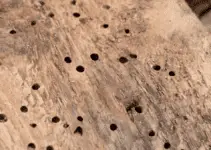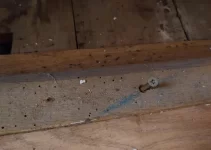Woodworm is a very common problem in the UK. It can affect nearly every type of wooden building, from sheds to barns to commercial properties.
Woodworm is a very unpleasant and destructive problem in homes. If you have woodworm you need to get rid of it as soon as possible before it causes more and more damage.
As a homeowner, it’s important to know how to spot the signs of woodworm and what you can do to prevent it from affecting your property.
How does woodworm start? Woodworm starts in high moisture content within timber as well as a number of other conditions.
Where does it start? This blog will give you all the information you need to know about woodworm and how it starts in the first place.
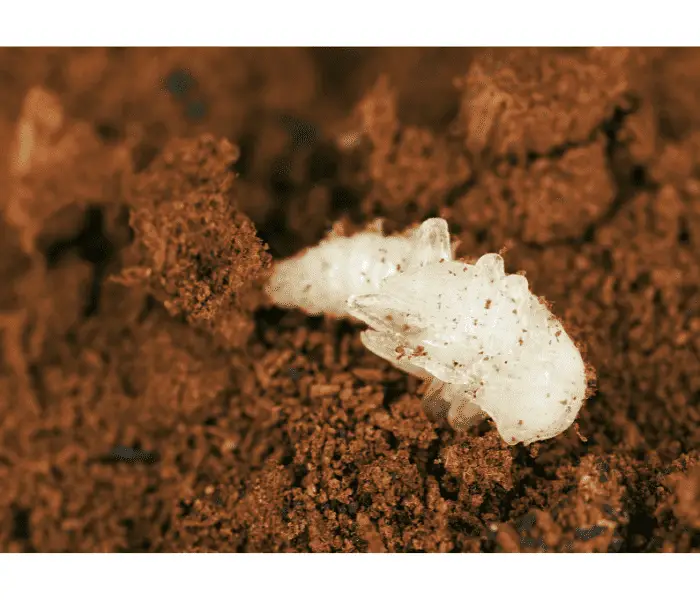
How Does Woodworm Start In A House?
Woodworm starts in a house with an adult beetle, which lays its eggs on or near a suitable piece of wood. Once the eggs hatch, the larvae start to feed on the wood, and over time they will burrow deep into the timber.
They stay there until they pupate and emerge as adult beetles, ready to start the cycle again.
The life cycle of woodworm can vary depending on the species, but it generally takes between two and five years for an adult beetle to emerge.
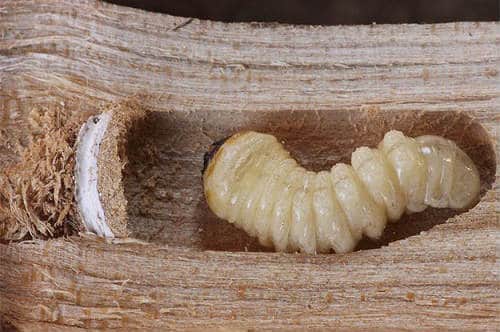
How Does Woodworm Start in a House?
Adult wood-boring insects can enter properties in a variety of ways. These may include being brought in on furniture, firewood, or packaging and can be transferred from one building to another.
However, the eggs are laid in the timber by the adult female beetles and it is these larvae that cause the damage.
The beetle larvae feed on the timbers within a property, growing and developing through different stages until they finally emerge as adults. The adult beetles will then mate and lay eggs in suitable areas of wood, starting the cycle again.
Some of the most common causes for this include:
Moisture
Woodworm thrive in damp conditions, so areas of high humidity or places where there is a lot of moisture in the air are more susceptible to infestations.
Poor Ventilation
Poor ventilation can create the ideal conditions for woodworm, as it can prevent the timber from drying out properly, making it more attractive to the beetles.
Damage
Damaged or rotten wood is more likely to be infested by woodworm, as the larvae can easily penetrate the surface.
Old Furniture
Older pieces of furniture that have been used and abused are more likely to be infested with woodworm, as the larvae can travel through cracks and crevices in the timber.
For any DIY woodworm treatment at home, I recommend:
What Are The Signs Of Woodworm?
There are different signs that can alert you to the presence of woodworm, some of which are more obvious than others. Here we discuss the main indicators of a woodworm problem.
If you think you might have woodworm, these are some tell-tale signs to look out for:
Holes In The Wood
Damage from woodworm beetles can be anything from very minor to severe, depending on the type of beetle and the extent of the infestation.
The most visible sign of woodworm is a series of holes in the surface of any wooden object. These holes are where the adult beetles have emerged from the timber after several years as larvae.
Woodworm exit holes are usually round, about 2mm across, and are often found in smaller groups. In badly infested timbers, you may find many more around the same area.
The holes are caused by adult beetles emerging from the timber. They can occur in clusters or be scattered over an infested area.
These holes are caused by adult beetles as they chew their way out of the timber, leaving behind frass (woodworm droppings), which can look like fine powder or small pellets.
This frass can often be seen around the holes themselves, and on surfaces beneath infested timbers.
If a floorboard is lifted you may also see the tunnels made by woodworm larvae as they have eaten their way through the timber. These are usually filled with frass and will usually run parallel to each other, along the grain of the timber.
You should also look for new or fresh-looking holes, which indicate that the infestation is active and ongoing, rather than old or historic in nature.
You may also see exit holes in softwoods that look oval-shaped with tunnel marks leading to them – these will usually only be present in softwoods because adult beetles can easily chew through this type of timber.
In properties with long-standing woodworm problems, it may be necessary to lift floorboards and remove sections of skirting boards and architraves in order to get a better look at the condition of the timbers.
Presence Of Larvae Tunnels
There is a presence of larvae tunnels within affected timber, which are filled with excrement known as frass, or ‘woodworm dust’.
These tunnels are normally found below the surface of wood and signified by a thinning of the wood between the holes. The tunnels can be up to 3m long and packed with frass.
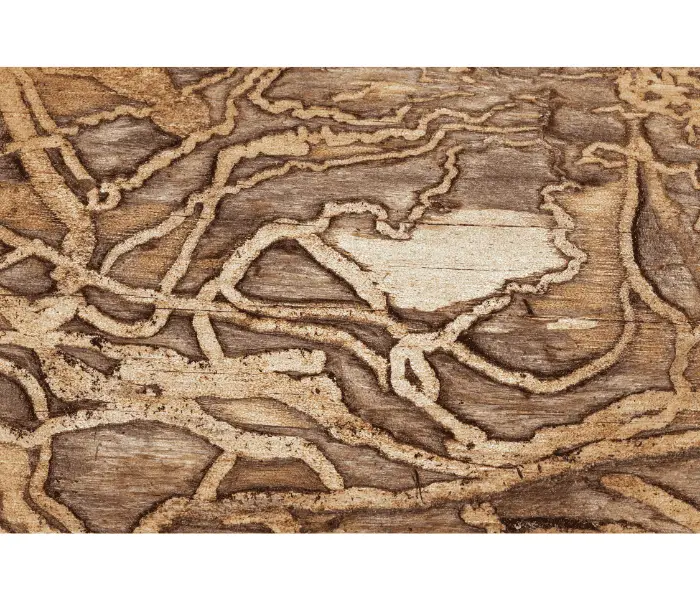
Crumbling And Weak Timber
As the woodworm larvae tunnel through the timber, they cause it to become structurally weak and in some cases, the timber may even collapse.
Advanced stages of woodworm attack can cause structural damage to both softwood and hardwood timbers. This damage is usually found around joints or other areas where timbers are connected together under constant load or stress.
Hollowed Timbers
Infested timber can often sound hollow when struck or tapped with something hard. This is because the larvae eat away at the timber from the inside, making it weak and brittle.
If this happens, there is a good chance that woodworm is present or has damaged the wood in some way.
Presence Of Frass (Woodworm Droppings)
Another key sign of an active infestation is frass – sawdust-like excrement and debris left by the grubs in their tunnels. This debris can be found beneath or near to exit holes.
The frass is from the larvae and is the waste product of their digestion. The frass looks like fine sawdust and differs slightly depending on what species of woodworm beetle is responsible for it.
The most common woodworm infestations in UK homes are caused by Common Furniture Beetle, however, we sometimes see Deathwatch Beetle and House Longhorn Beetle too. Each of these infestations has very different looking frass.
As the larvae tunnel through the wood, they munch on it and expel frass out of the exit holes. The frass will accumulate around the hole and on any surface below it.
Adult furniture beetle frass looks like coarse sawdust and is easily visible when it falls out of infested timbers onto floors or skirting boards.
Deathwatch beetle frass is also easily visible but looks slightly finer and contains pellets, while house longhorn beetle frass is much finer and more difficult to spot.
If you see some of these signs, it is extremely likely that your property has an active infestation; this means that you should seek professional help as soon as possible.
FAQs
How Long Does It Take For Woodworm To Appear?
The time it takes for woodworm to appear varies depending on the species of beetle and the environmental conditions.
In most cases, it can take between 6 and 12 months for woodworm eggs to hatch into larvae. The larvae will then feed on the timber for a further 2-5 years, before emerging as adults.
How Can You Tell If Woodworm Is Active?
The most common signs of an active woodworm infestation are the presence of tunnels, frass, and exit holes. If you see any of these signs, it is likely that your property has an active infestation and you should seek professional help as soon as possible.
Can Woodworm Go Away On Its Own?
No, woodworm will not go away on its own and will continue to cause damage to the timber if left untreated. It is therefore important to seek professional help as soon as you suspect that your property has an infestation.
Does Woodworm Spread Quickly?
Woodworm can spread quickly if left untreated, as the adults can fly and lay eggs in other areas of timber. However, the larvae do not move far from the egg-laying site and will only spread if the timber is moved.
How Does Woodworm Start – Final Thoughts
This article demonstrated how woodworm infestations begin in the home with adult beetles laying eggs in timber crevices. Wood moisture and warmer environments are key factors accelerating this process.
Understanding these origins helps in identifying preventative measures and implementing effective treatments to combat and control these damaging pests in our homes and wooden structures.

